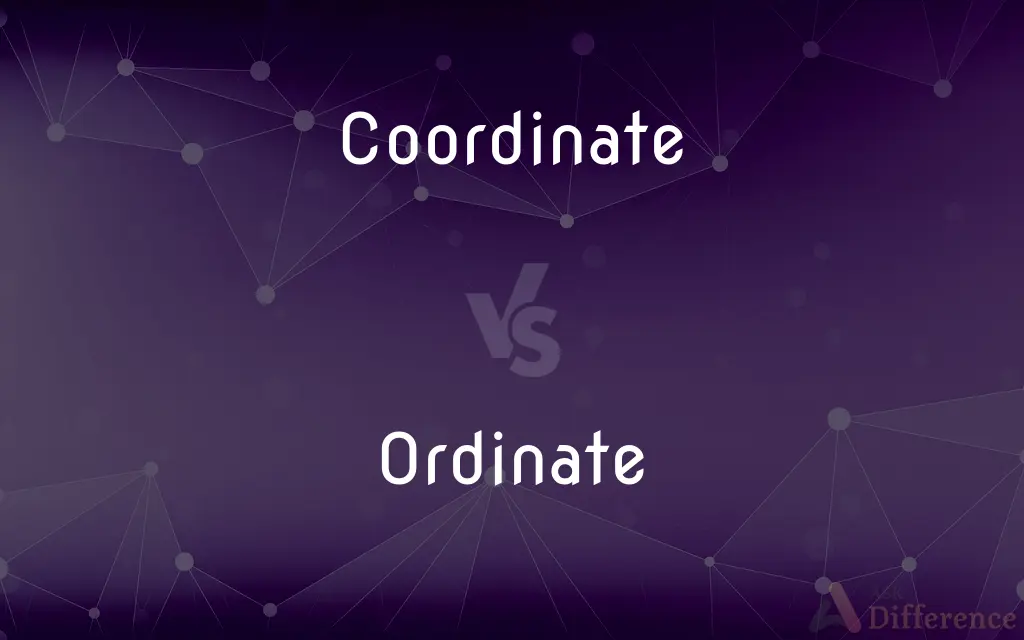Coordinate vs. Ordinate — What's the Difference?
By Urooj Arif & Maham Liaqat — Updated on March 29, 2024
Coordinates are a set of values that show an exact position, while an ordinate specifically refers to the vertical position, usually in a 2D coordinate system.

Difference Between Coordinate and Ordinate
Table of Contents
ADVERTISEMENT
Key Differences
Coordinates are used in mathematics and geography to specify the position of a point in a space, which can be two-dimensional, three-dimensional, or even higher-dimensional. These values describe a point's location in relation to a defined reference system, such as latitude and longitude on Earth or the x, y (and z) axes in Cartesian coordinates. The ordinate, on the other hand, specifically refers to the second element in an ordered pair in a two-dimensional space, representing the vertical position of a point. It is often denoted by y in the Cartesian coordinate system.
While coordinates provide a complete picture of a point's location, the ordinate gives information about the point's height or depth within a plane, depending on the context. For example, in a graph representing economic growth, the ordinate could represent the growth rate, while the coordinate pair indicates a specific point in time and its corresponding growth rate.
In application, coordinates are essential for navigation, mapping, and in various fields of science and engineering where precise locations are critical. Ordinates, being part of the coordinate system, are crucial for understanding and interpreting the vertical component of these locations or values in graphs and charts.
The concept of coordinates extends beyond the physical representation on graphs to include abstract dimensions in mathematics, whereas ordinates are specifically tied to the notion of vertical positioning within a two-dimensional framework. This distinction highlights the broader applicability of coordinates compared to the more specialized role of ordinates.
Despite their differences, both coordinates and ordinates are fundamental to the study of geometry, physics, and any discipline that requires precise representation of points in space. They allow for the clear communication and analysis of spatial relationships and quantitative data.
ADVERTISEMENT
Comparison Chart
Definition
A set of values that specify the position of a point
The vertical position of a point in a 2D space
Representation
Can be one-dimensional, two-dimensional, or multi-dimensional
Specifically the second value in a 2D coordinate system (y-value)
Usage
Navigation, mapping, science, engineering
Graphs, charts to represent vertical positioning
Context
Broad applicability across various fields
Limited to vertical positioning within a plane
Denoted Usually As
(x, y, z) for 3D spaces, (x, y) for 2D spaces
Y in a 2D Cartesian coordinate system
Compare with Definitions
Coordinate
A numerical value specifying a position in space.
The GPS coordinates (45.4215° N, 75.6972° W) locate Ottawa on a map.
Ordinate
The y-value in a (x, y) pair in 2D Cartesian coordinates, indicating vertical position.
In the point (3, 4), 4 is the ordinate.
Coordinate
A system used to uniquely ascertain the position of a point or object.
Astronomers use celestial coordinates to identify stars' locations.
Ordinate
In geometry, the vertical distance from the x-axis.
The ordinate of the vertex indicates its height above the x-axis.
Coordinate
Values that determine a location within a given reference frame.
The treasure is marked at coordinates X: 100, Y: 200 on the island map.
Ordinate
A term specifically used for the vertical component in 2D systems.
Adjusting the ordinate can change an object's elevation on a plot.
Coordinate
In mathematics, a set of numbers defining the position of a point.
The coordinate (0,0) represents the origin in Cartesian space.
Ordinate
A measure of height or depth on a graph.
The graph peaks at an ordinate of 5 units.
Coordinate
In computer graphics, a value that defines the position of pixels or vertices.
The texture coordinate (0.5, 0.5) corresponds to the center of a texture map.
Ordinate
Used in statistics to represent data points vertically.
Each ordinate on the histogram represents frequency count.
Coordinate
Bring the different elements of (a complex activity or organization) into a harmonious or efficient relationship
He had responsibility for coordinating London's transport services
Ordinate
Arranged in regular rows, as the spots on the wings of an insect.
Coordinate
Form a coordinate bond to (an atom or molecule)
The sodium atom is coordinated to two oxygen atoms
Ordinate
Symbol y The plane Cartesian coordinate representing the distance from a specified point to the x-axis, measured parallel to the y-axis.
Coordinate
Equal in rank or importance
Cross references in the catalogue link subjects which may be coordinate
Ordinate
(geometry) The second of the two terms by which a point is referred to, in a system of fixed rectilinear coordinate (Cartesian coordinate) axes.
The point has 3 as its abscissa and 2 as its ordinate.
Coordinate
Denoting a type of covalent bond in which one atom provides both the shared electrons.
Ordinate
(geometry) The vertical line representing an axis of a Cartesian coordinate system, on which the ordinate (sense above) is shown.
Coordinate
Each of a group of numbers used to indicate the position of a point, line, or plane.
Ordinate
To ordain a priest, or consecrate a bishop
Coordinate
Matching items of clothing
Matching accessories provide a complete ensemble of colour coordinates
Ordinate
(transitive) to align a series of objects
Coordinate
(Mathematics)Any of a set of two or more numbers used to determine the position of a point, line, curve, or plane in a space of a given dimension with respect to a system of lines or other fixed references.
Ordinate
Arranged regularly in rows; orderly; disposed or arranged in an orderly or regular fashion.
Coordinate
Coordinates Informal Directions
Give me some coordinates so I can find my way.
Ordinate
Well-ordered; orderly; regular; methodical.
Coordinate
Coordinates A set of articles, as of clothing or luggage, designed to match or complement one other, as in style or color.
Ordinate
The distance of any point in a curve or a straight line, measured on a line called the axis of ordinates or on a line parallel to it, from another line called the axis of abscissas, on which the corresponding abscissa of the point is measured.
Coordinate
Of equal importance, rank, or degree
Jobs with coordinate responsibilities.
Ordinate
To appoint, to regulate; to harmonize.
Coordinate
(Grammar)Having equal syntactic status; not subordinate
Coordinate phrases.
Ordinate
The value of a coordinate on the vertical axis
Coordinate
(Mathematics)Of or based on a system of coordinates.
Ordinate
Appoint to a clerical posts;
He was ordained in the Church
Coordinate
To cause to work or function in a common action or effort
Coordinating the moving parts of a machine.
Ordinate
Bring (components or parts) into proper or desirable coordination correlation;
Align the wheels of my car
Ordinate similar parts
Coordinate
To make harmonious; harmonize
Coordinate the colors of a design.
Coordinate
(Grammar)To link (syntactic units) at an equal level.
Coordinate
To work or function together harmoniously
A nursing staff that coordinates smoothly.
Coordinate
To form a harmonious combination; match
Shoes that coordinate with the rest of the outfit.
Coordinate
Of the same rank; equal.
Two coordinate terms
Coordinate
A number representing the position of a point along a line, arc, or similar one-dimensional figure.
Give me your coordinates and we'll come and rescue you.
Coordinate
Something that is equal to another thing.
Coordinate
Coordinated clothes.
Coordinate
(transitive) To place in the same order or rank.
Coordinate
(ambitransitive) To synchronize (activities).
It can be difficult to coordinate movement of both legs after an operation.
I was playing tennis for the first time, and it was difficult to coordinate.
Coordinate
(ambitransitive) To match (objects, especially clothes).
The outfit you're wearing doesn't coordinate.
Coordinate
Equal in rank or order; not subordinate.
Whether there was one Supreme Governor of the world, or many coördinate powers presiding over each country.
Conjunctions joint sentences and coördinate terms.
Coordinate
A thing of the same rank with another thing; one two or more persons or things of equal rank, authority, or importance.
It has neither coördinate nor analogon; it is absolutely one.
Coordinate
Lines, or other elements of reference, by means of which the position of any point, as of a curve, is defined with respect to certain fixed lines, or planes, called coördinate axes and coördinate planes. See Abscissa.
Coordinate
A number that identifies a position relative to an axis
Coordinate
Bring order and organization to;
Can you help me organize my files?
Coordinate
Bring into common action, movement, or condition;
Coordinate the painters, masons, and plumbers
Coordinate his actions with that of his colleagues
Coordinate our efforts
Coordinate
Be co-ordinated;
These activities co-ordinate well
Coordinate
Bring (components or parts) into proper or desirable coordination correlation;
Align the wheels of my car
Ordinate similar parts
Coordinate
Of equal importance, rank, or degree
Common Curiosities
How are coordinates used in real life?
Coordinates are used in GPS for navigation, in mapping, and in various scientific and engineering applications to specify locations.
What is the difference between a coordinate and an ordinate?
A coordinate specifies an exact location in space, while an ordinate refers specifically to the vertical position in a 2D coordinate system.
Can coordinates be used in three-dimensional space?
Yes, in three-dimensional space, coordinates are represented by three values, usually (x, y, z), specifying width, depth, and height.
Can ordinates exist without coordinates?
Ordinates are part of the coordinate system, so they don't stand alone; they always exist within the context of coordinates.
Why are both coordinates and ordinates necessary in mathematical representations?
Both are necessary to fully describe the position of points in space, with coordinates providing the complete picture and ordinates offering detailed vertical positioning.
Why is the ordinate important in graphs?
The ordinate is crucial for understanding the vertical aspect of points on a graph, such as height, depth, or any other vertical measurement.
What makes coordinates fundamental in navigation?
Coordinates provide a universal language for location, allowing precise navigation across the globe or in specific areas.
Can the concept of ordinates be applied to three-dimensional models?
In three-dimensional models, the concept of vertical positioning is extended beyond ordinates to include a z-axis, but the term "ordinate" specifically refers to 2D vertical positioning.
Can ordinates change based on the graph?
The value of an ordinate changes based on its position in the graph, but it always represents a vertical measurement or position.
How does understanding ordinates help in data analysis?
Understanding ordinates allows analysts to interpret the vertical dimension of data, crucial for identifying trends, peaks, and valleys in datasets.
Is there an equivalent to the ordinate for the horizontal position?
Yes, the horizontal position in a 2D coordinate system is called the abscissa, usually denoted by x.
How do coordinates relate to maps?
Coordinates are essential for maps, providing a precise way to locate places globally using latitude and longitude.
How do ordinates aid in geographical studies?
Ordinates, as part of geographical coordinates, assist in understanding the elevation or depth of locations on Earth, important for topographical maps and studies.
Are coordinates only used in physical spaces?
No, coordinates are also used in abstract spaces, like in mathematics and computer science, to describe positions in conceptual or virtual spaces.
What role do ordinates play in architecture?
Ordinates help architects and engineers to determine the vertical aspects of structures on plans and elevation drawings.
Share Your Discovery

Previous Comparison
Labneh vs. Laban
Next Comparison
Carbonisation vs. CarbonizationAuthor Spotlight
Written by
Urooj ArifUrooj is a skilled content writer at Ask Difference, known for her exceptional ability to simplify complex topics into engaging and informative content. With a passion for research and a flair for clear, concise writing, she consistently delivers articles that resonate with our diverse audience.
Co-written by
Maham Liaqat













































